- Hola, galera! Espero de corazón que hayan tenido un fin de semana agradable. Yo si he tenido un fin de semana agradable de introspección y creatividad.
Ya llevo algunos dias usando Ecency y la verdad es que cada vez se hace mas placentero y satisfactorio estar aqui. Quiero usar mi perfil para apoyar artistas y para compartir mis trabajos y reflexiones.
Y esta es mi propuesta de hoy:
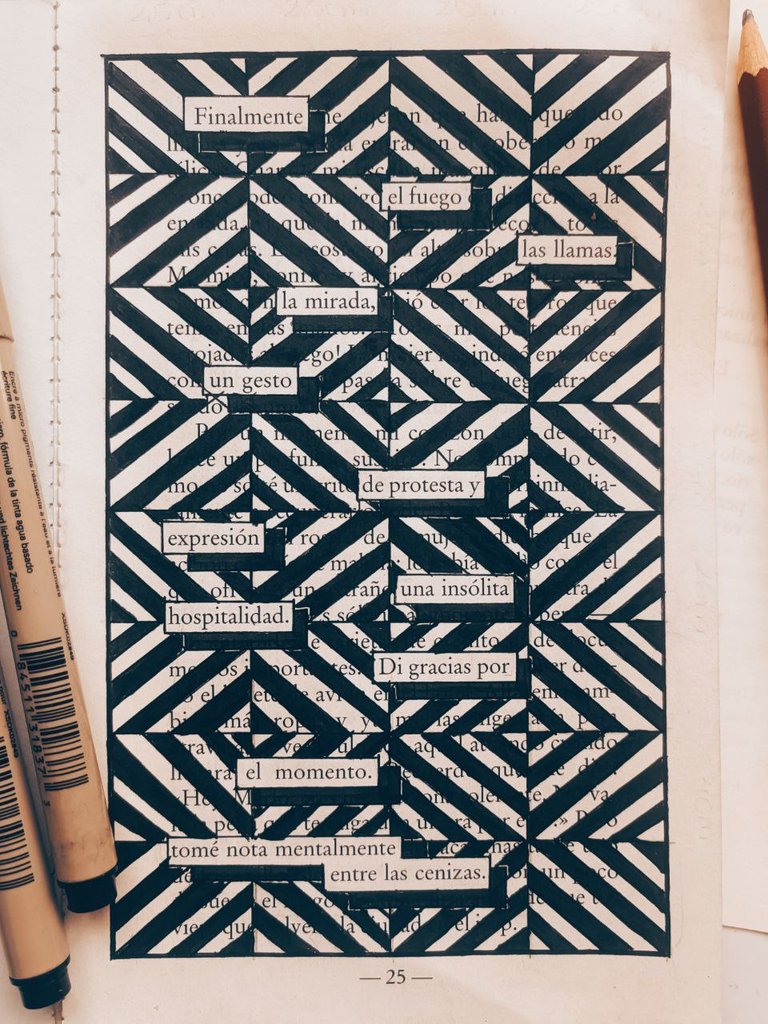
Usar la creatividad para crear una poesía tachada del libro que más (o menos) te guste.
Para empezar, quiero dejar una breve explicación sobre que es la poesía tachada y el zentangle.
- La poesía tachada es una técnica de creación literaria en la que se parte de un texto ya existente—como un periódico, una página de un libro o una revista—y se tachan palabras o frases para revelar un nuevo mensaje poético.
El proceso consiste en seleccionar palabras clave y cubrir el resto del texto con tinta, pintura u otros medios, dejando visible solo la parte que forma el poema. Esta técnica, que combina literatura y artes visuales, es una forma de poesía experimental y un ejercicio creativo de reinterpretación del lenguaje.
- El Zentangle es un método de dibujo basado en la creación de patrones repetitivos y estructurados para fomentar la relajación, la concentración y la creatividad. Fue desarrollado por Rick Roberts y Maria Thomas y se caracteriza por el uso de líneas, formas y texturas organizadas en pequeños espacios delimitados.
- Para mí, el arte es una forma de meditación. Crear en silencio, otras veces con musica, conectar con el presente y llenar el espacio de energía.
Mi inspiración está en la naturaleza y sus formas, asi como en patrones geometricos y las repeticiones. Es como un mantra que me trae al presente y a la atención plena.
Al centrarme en patrones repetitivos y simétricos, mi mente se calma, ayudándome a liberar tensiones y alcanzar un estado de serenidad.
Para mi es el proceso ideal para desconectar de las rutinas y sumergirme en un proyecto relajante. El papel se convierte en un refugio de calma y creatividad.
No trato de crear una obra perfecta, si no de vivir una experiencia auténtica. Sin juzgar ni buscar un resultado final específico, porque cada línea es perfecta como es, porque refleja mi energía en ese momento y me hizo darme cuenta de que lo que al principio parecía un error o una línea mal hecha, al final se transforma en una parte hermosa de mi obra.
- Conocí los patrones de zentangle durante el covid y fue todo un descubrimiento para mi, me hizo vivir una cuarentena mucho más amena. Aqui en España, mientras muchas personas se estaban haciendo daño mentalmente llenándose de preocupaciones e inseguridades, yo estaba comprobando que la repeticion de patrones realmente funcionaba para calmarme y concentrarme. Cada día a las 5 o 6 de la tarde, me preparaba con papel y boli para el live de una artista de zentangle que seguía en instagram. Eran lives de 1 hora, donde yo aprendía a crear obras hermosas a través de repetir patrones y a poner mi atención no solo en lo que dibujaba si no también en mi cuerpo, en como estaba sentada en la silla apoyando mis dos pies en el suelo y en mi respiración mientras hacía las líneas. Siento mucha gratitud por ese momento porque me ayudo a conseguir plenitud en mi día a día, más allá del momento de dibujar.
Y justamente por todos los beneficios que experimento a través de esta arte terapia, me gustaría compartir con todos y todas, un tutorial simple y práctico para que también puedan disfrutar de su creatividad.
Es un guía básico que te puede servir para montar tu propio esqueleto de tu "página sagrada", pero no necesariamente tienes que usar el mismo patrón que utilizo yo en el ejemplo. Puedes encontrar muchos otros patrones buscando tutoriales de zentamgle en YouTube, también hay libros y muchos perfiles en las redes sociales dedicados solamente a eso. Háganme saber si les interesa que comparta en un post más info sobre esos libros y esos perfiles. De todas maneras, por más que repitas los mismos patrones que he utilizado, nuestra obra será muy diferente porque usarás otro libro, otra página, así que ya para empezar nuestra frase no será la misma.
Espero sinceramente que este tutorial sirva de algo, aunque les pido por favor que sean pacientes y amables conmigo porque es mi primer tutorial.
Ojalá lo disfrutes y te sirva de algo. 😊
1 - Lo primero que hay que hacer es elegir un libro, posteriormente elegir una página - la que más te guste o resuene, la que te inspire. Luego marcar con lapis palabras o pequeñas frases aleatorias que formen una nueva frase. La foto no es la mejor, pero si la amplias puedes ver mis marcaciones en la página.
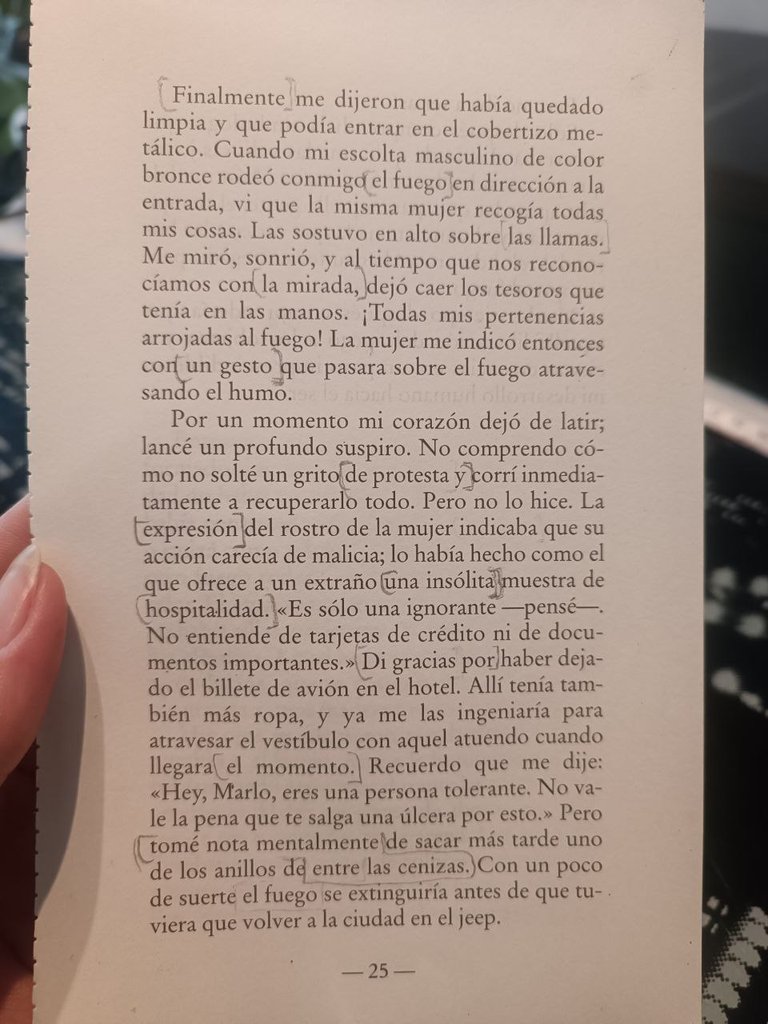
2 - Luego, con un boli - en este caso negro - crea un contorno alrededor de esas marcaciones, haciendo que se queden dentro de pequeños retangulos, como en la próxima imagen:

3 - Después, con el mismo boli, crea las sombras, como en la siguiente imagen:

4 - Ahora, con una regla, mide los laterales y uniendo los puntos de medidas con lapiz, crea los cuadrados (más bien retangulos) donde vas a dibujar tus patrones (aqui creamos cuadrados, pero también pueden ser triángulos, círculos, columnas, líneas...).
En la imagen verás que marque a lapis las medidas laterales de mis "cuadrados". Os dejo dos opciones distintas de medidas, pero yo finalmente opte por la opción 2 (de 2cm):
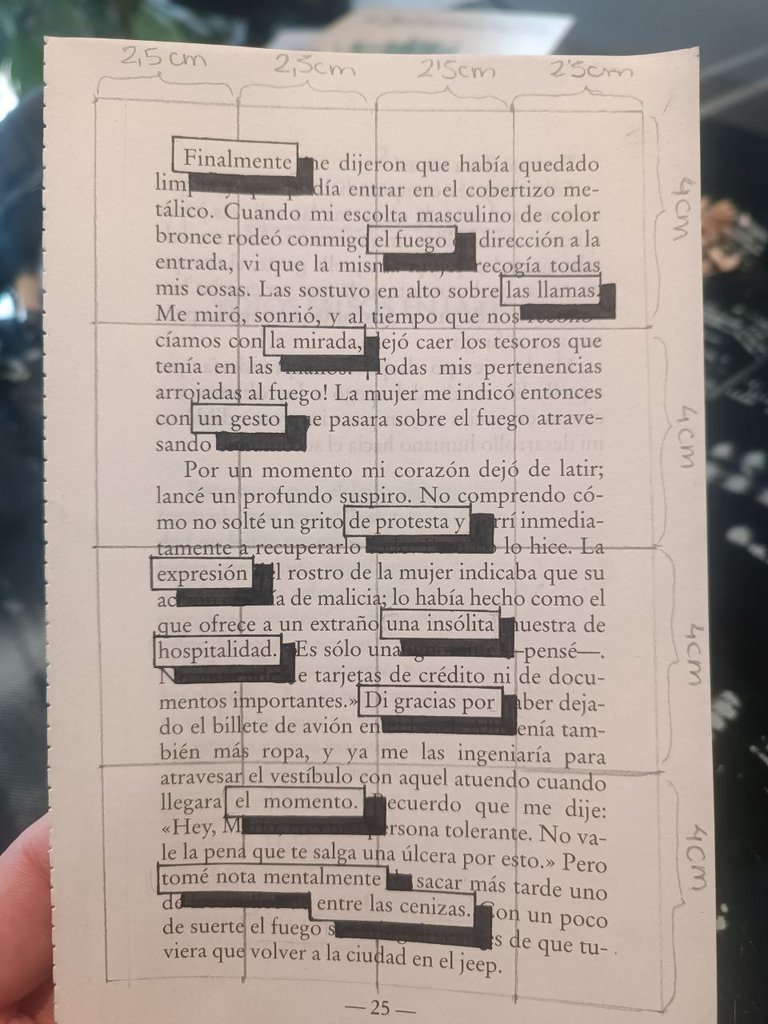

Las líneas laterales completas son de 16cm, mientras las líneas superior e inferior son de 10cm cada una.
5 - Ahora, con extremo cuidado para no pasar por encima de las palabras y frases destacadas, marca esos "cuadrados" con el boli y empieza a dibujar tu patrón dentro de los dos primeros "cuadrados" que elijas. - Yo elegí empezar por el centro simplemente porque para mi parecía más fácil.
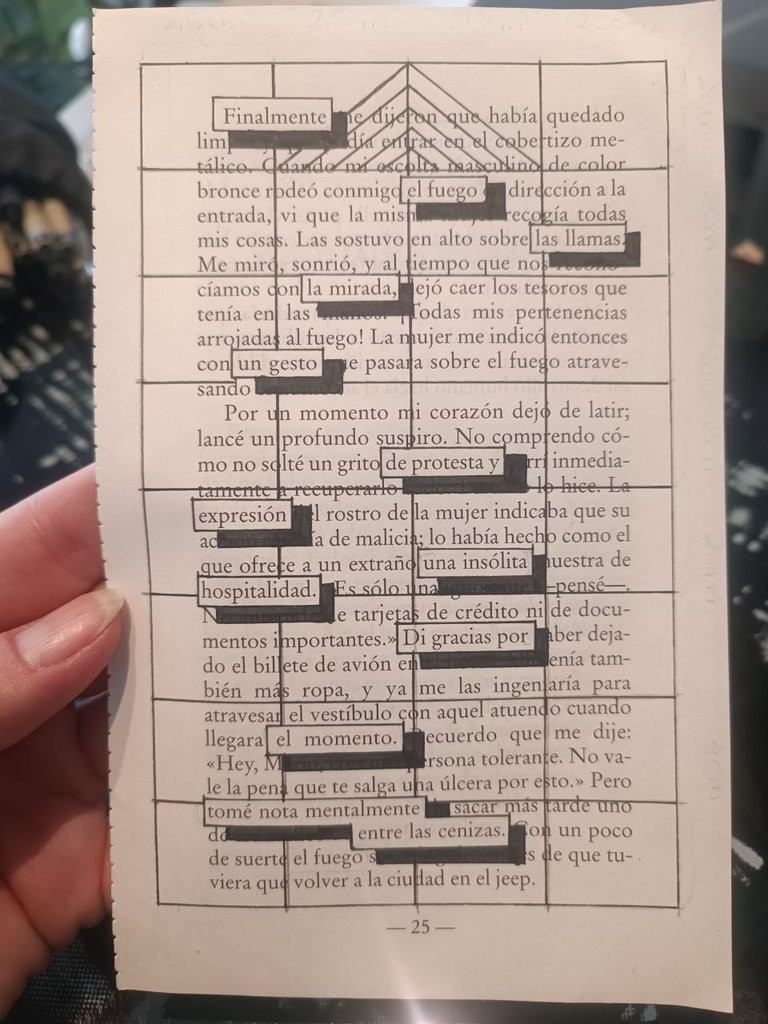
6 - Sigue realizando la repeticion de los patrones y si lo deseas ya puedes empezar a pintar de negro las partes que quieras. Aquí también tienes la opción de realizar las líneas de los patrones en todos los "cuadrados" y dejarlos así.
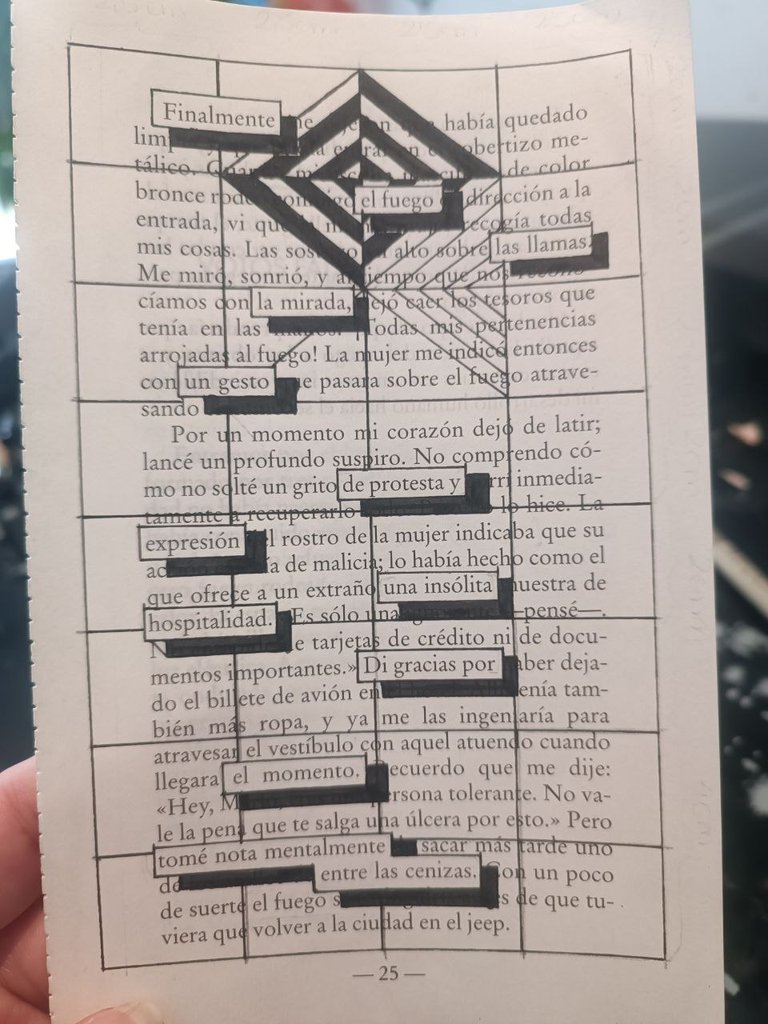
Yo intercale blancos y negros por puro gusto, pero puedes hacerlo de la manera que más te guste. Acuérdate que aquí no hay errores. Cada obra es única.
7 - Finalmente así es como quedó mi arte terminada:

Para los dibujos utilice bolis Micron, que son rotuladores de tinta de archivo con punta fina de fibra, muy usados en dibujo técnico, ilustración, Zentangle, cómic y escritura.
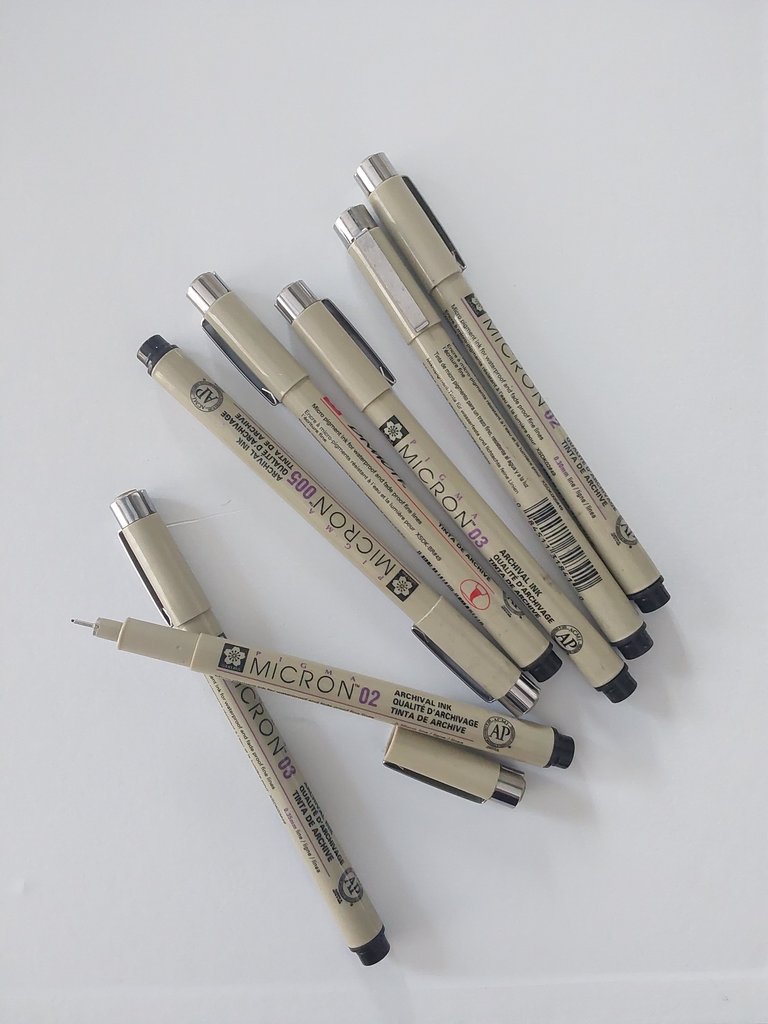
Para crear la poesía, use la página 25 del libro "Las voces del desierto", de Marlo Morgan.
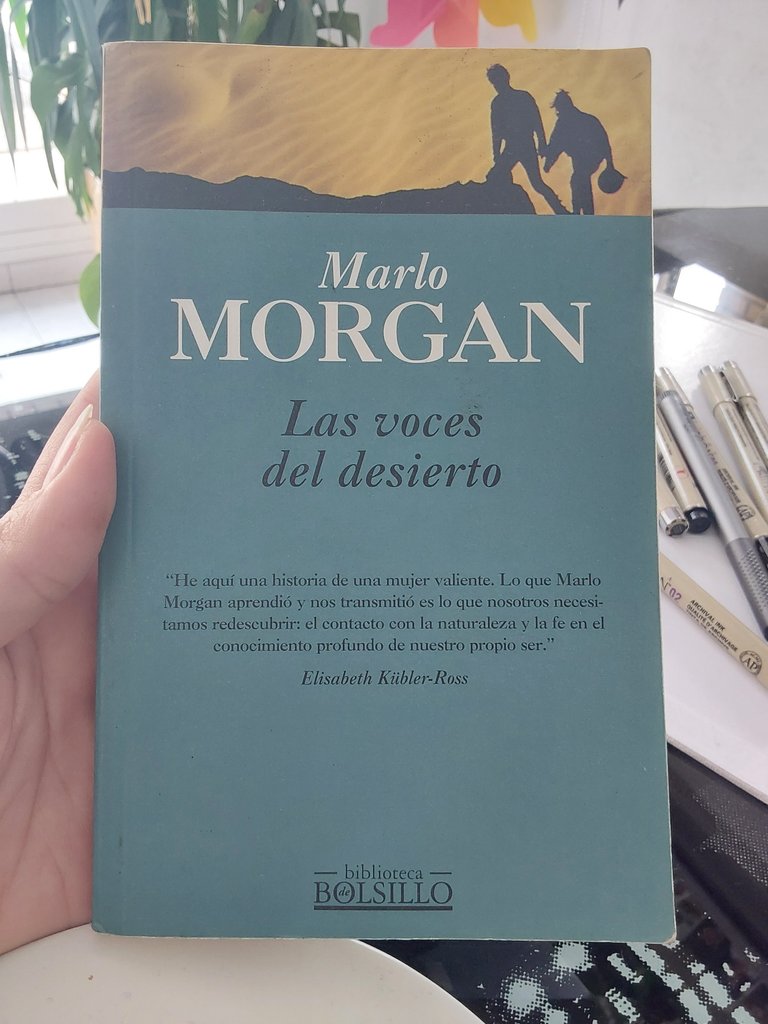
A mi sinceramente me gusta la frase que cree y espero que a ti también, pero sobretodo, espero que este tutorial te sirva para pasar un lindo momento de creación y calma contigo mismo.
Y si has llegado hasta aquí, te doy las gracias y te mando un súper abrazo.
Me despido dejandote un poco mas de mi trabajo.
Espero volver a verte pronto por aquí.
Saludos.



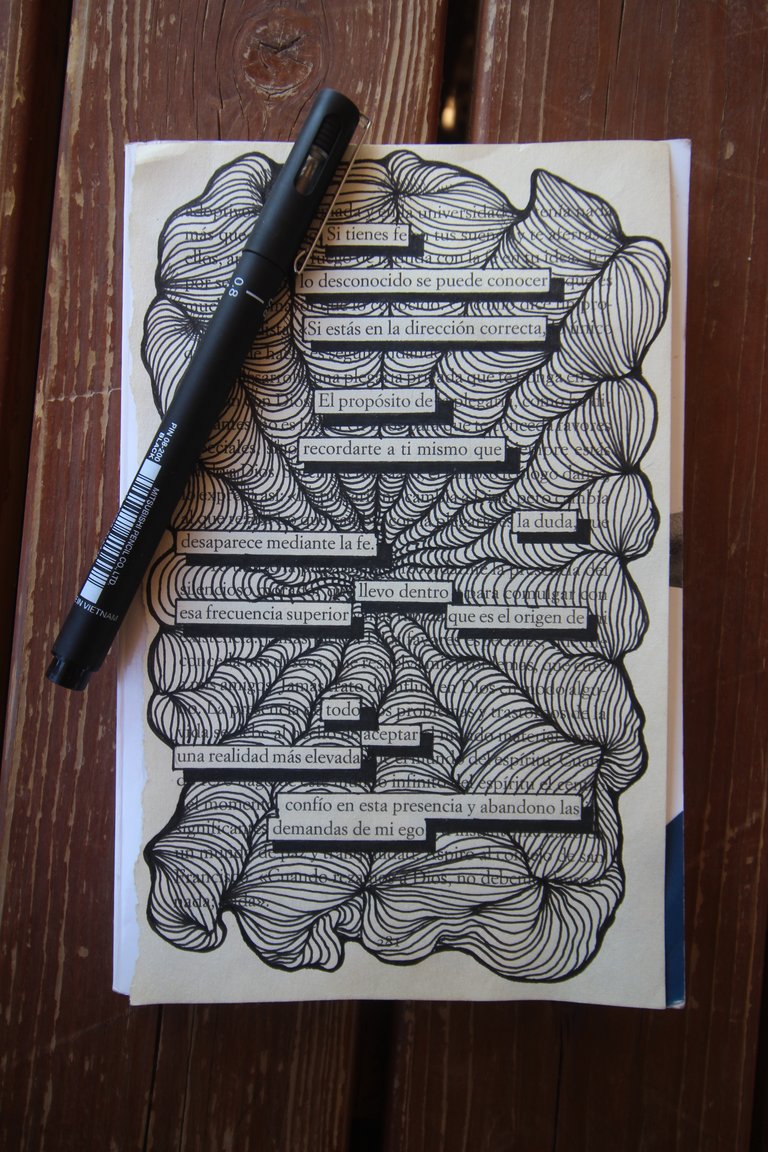

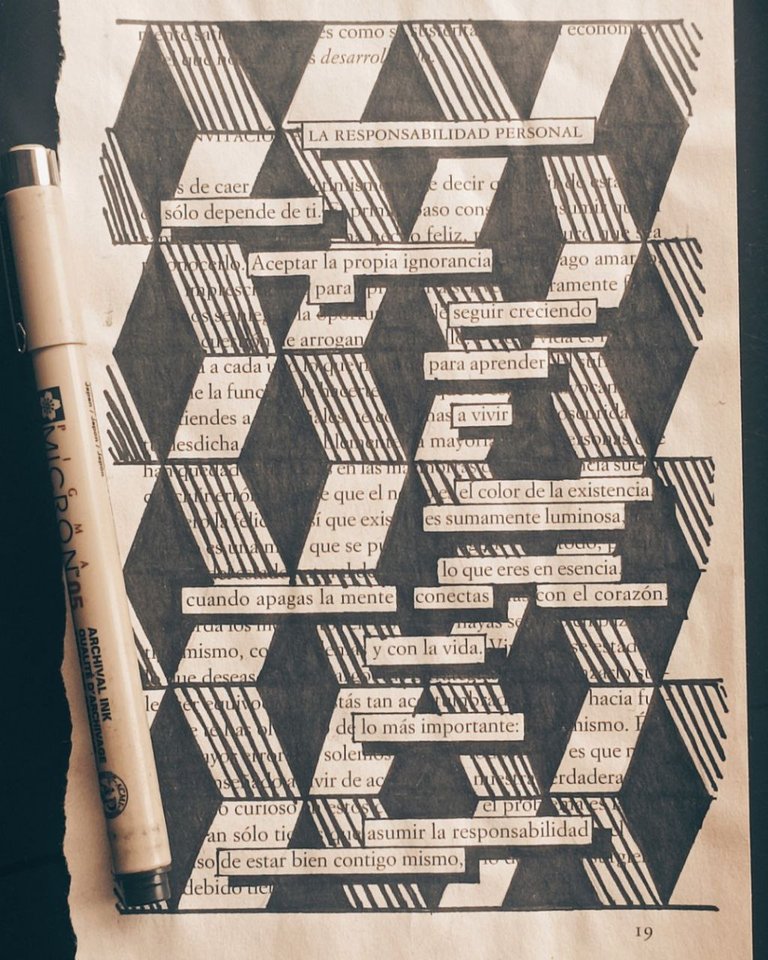
English:
Hello, everyone! I sincerely hope you all had a great weekend. I had a wonderful weekend filled with introspection and creativity.
I've been using Ecency for a few days now, and honestly, it’s becoming more and more enjoyable and fulfilling to be here. I want to use my profile to support artists and to share my work and reflections.
And here is my proposal for today:

Use creativity to create a blackout poetry from the book you like (or dislike) the most.
To start, I’d like to give a brief explanation of what blackout poetry and zentangle are.
- Blackout poetry is a literary technique that takes an existing text—such as a newspaper, a book page, or a magazine—and removes words or phrases to reveal a new poetic message.
The process involves selecting key words and covering the rest of the text with ink, paint, or other media, leaving only the parts that form the poem visible. This technique, which merges literature and visual arts, is a form of experimental poetry and a creative exercise in reinterpreting language.
- Zentangle is a drawing method based on creating repetitive, structured patterns to encourage relaxation, focus, and creativity. It was developed by Rick Roberts and Maria Thomas and is characterized by the use of lines, shapes, and textures arranged within small, defined spaces.
For me, art is a form of meditation. Creating in silence, sometimes with music, connecting with the present, and filling the space with energy.
My inspiration comes from nature and its shapes, as well as geometric patterns and repetitions. It’s like a mantra that brings me to the present and into mindfulness.
By focusing on repetitive and symmetrical patterns, my mind calms down, helping me release tension and reach a state of serenity.
For me, it’s the perfect process to disconnect from routines and immerse myself in a relaxing project. The paper becomes a refuge of calm and creativity.
I don’t aim to create a perfect piece, but to live an authentic experience. Without judging or seeking a specific final result, because every line is perfect as it is—it reflects my energy in that moment. I’ve realized that what at first seemed like a mistake or a misplaced line eventually becomes a beautiful part of my artwork.
I discovered Zentangle patterns during COVID, and it was a true revelation for me—it made my quarantine much more enjoyable. Here in Spain, while many people were struggling mentally, filled with worries and insecurities, I was experiencing firsthand how repeating patterns truly helped me calm down and focus. Every day at 5 or 6 in the afternoon, I would prepare my paper and pen for a live session by a Zentangle artist I followed on Instagram. These were one-hour lives where I learned to create beautiful pieces by repeating patterns, while also paying attention not only to my drawing but also to my body—how I sat in my chair with both feet on the ground—and my breathing as I traced the lines. I feel immense gratitude for that time because it helped me achieve a sense of fulfillment in my daily life, beyond just the act of drawing.
And precisely because of all the benefits I experience through this form of art therapy, I’d love to share a simple and practical tutorial so that you, too, can enjoy your creativity.
It’s a basic guide that can help you build the structure of your own "sacred page." However, you don’t necessarily have to use the same pattern I use in the example. You can find many other patterns by searching for Zentangle tutorials on YouTube—there are also books and many social media profiles dedicated solely to this art form. Let me know if you’d like me to share more info about those books and profiles in a future post. Regardless, even if you repeat the same patterns I’ve used, our works will be entirely different because you’ll use a different book, a different page—so right from the start, our phrase won’t be the same.
I sincerely hope this tutorial is helpful in some way. I just ask that you be patient and kind with me, as this is my first tutorial.
I hope you enjoy it and find it useful! 😊
1 - The first thing to do is choose a book, then select a page—the one you like the most, the one that resonates with you, the one that inspires you. Next, use a pencil to mark random words or short phrases that form a new sentence. The photo isn’t the best, but if you zoom in, you can see my markings on the page.

2 - Then, using a pen—black in this case—draw an outline around the marked words, enclosing them in small rectangles, as shown in the next image.

3 - Then, using the same pen, create the shadows, as shown in the next image.

4 - Now, using a ruler, measure the sides and, by connecting the measurement points with a pencil, create the squares (or rather rectangles) where you will draw your patterns. Here we created squares, but they can also be triangles, circles, columns, or lines.
In the image, you’ll see that I marked the side measurements of my "squares" with a pencil. I’ve provided two different measurement options, but in the end, I chose option 2 (2 cm).


The full side lines measure 16 cm, while the top and bottom lines are each 10 cm.
5 - Now, with great care not to go over the highlighted words and phrases, outline the "squares" with the pen and start drawing your pattern inside the first two "squares" you choose. I chose to start in the center simply because it seemed easier to me.

6 - Continue repeating the patterns, and if you wish, you can start painting the areas you want in black. Here, you also have the option to complete the pattern lines in all the "squares" and leave them like that.

I alternated black and white purely for personal preference, but you can do it however you like. Remember, there are no mistakes here. Each artwork is unique.
7 - Finally, this is how my finished artwork looks:

For the drawings, I used Micron pens, which are archival ink markers with fine fiber tips. They are widely used in technical drawing, illustration, Zentangle, comics, and writing.

To create the poetry, I used page 25 of the book "Las voces del desierto" by Marlo Morgan.
I honestly like the phrase I created, and I hope you do too. But most of all, I hope this tutorial helps you have a lovely moment of creation and calm with yourself.
And if you've made it this far, thank you, and I send you a big hug. I say goodbye, leaving you with a little more of my work. I hope to see you again here soon. Best regards.






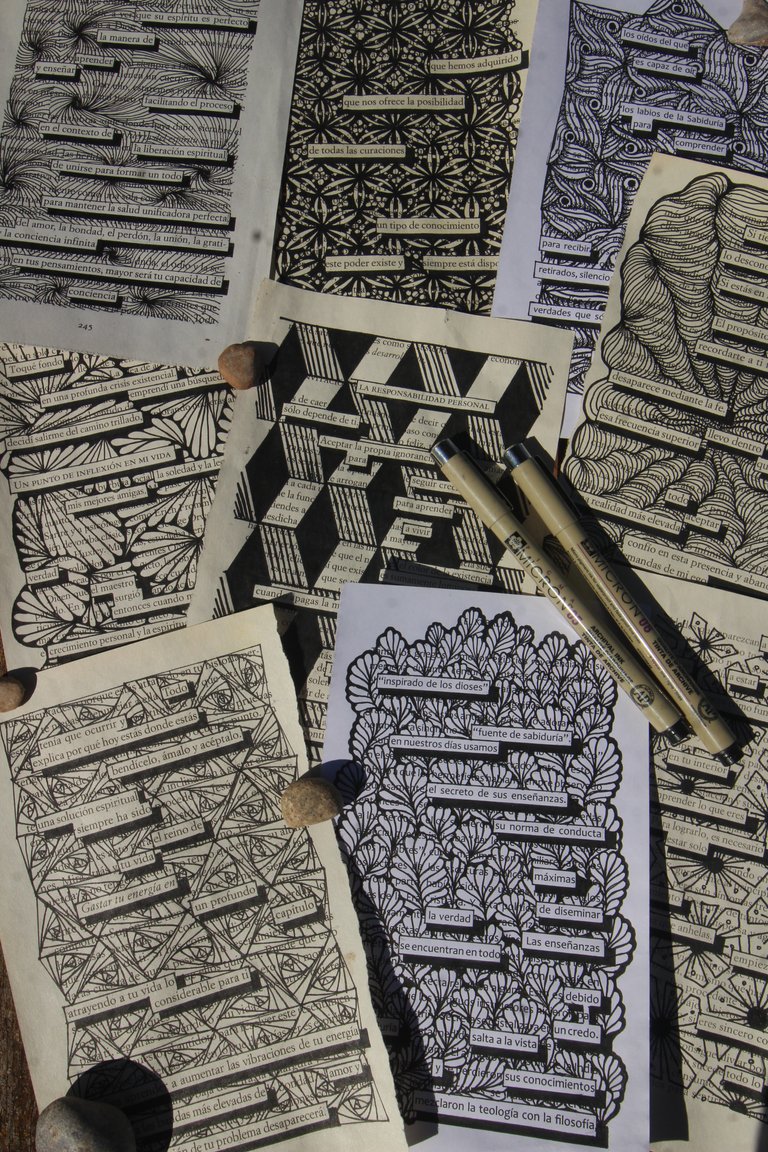
View or trade
LOHtokens.@lamica, You have received 1.0000 LOH for posting to Ladies of Hive.
We believe that you should be rewarded for the time and effort spent in creating articles. The goal is to encourage token holders to accumulate and hodl LOH tokens over a long period of time.
so cool!!
!discovery 30
🥰🥰🥰 super thanx! So Happy to share with people ❤️🔥 thank you!
This post was shared and voted inside the discord by the curators team of discovery-it
Join our Community and follow our Curation Trail
Discovery-it is also a Witness, vote for us here
Delegate to us for passive income. Check our 80% fee-back Program
Congratulations @lamica! You have completed the following achievement on the Hive blockchain And have been rewarded with New badge(s)
Your next target is to reach 600 upvotes.
You can view your badges on your board and compare yourself to others in the Ranking
If you no longer want to receive notifications, reply to this comment with the word
STOPThis is a really cool art.
Thank you for sharing
Thank you for the comment 🥰 and yeah, this is therapy ✨
View or trade
LOHtokens.@lamica, You have received 1.0000 LOH for posting to Ladies of Hive.
We believe that you should be rewarded for the time and effort spent in creating articles. The goal is to encourage token holders to accumulate and hodl LOH tokens over a long period of time.
[ESP]
Chulo !
me encanta. eres una genia ❤️
saludos.
[ENG]
Cool !
I love it. you are a genius ❤️
regards.
!LADY
View or trade
LOHtokens.Use !LADY command to share LOH! More details available in this post.@hive-124452, you successfully shared 0.1000 LOH with @lamica and you earned 0.1000 LOH as tips. (17/21 calls)
¡Interesante manera de redescubrir la poesía en lo cotidiano incluso!
¡Gracias por mostrarnos nuevas formas de leer y crear!